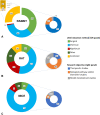Animal Models for Limbal Stem Cell Deficiency: A Critical Narrative Literature Review
- PMID: 38280103
- PMCID: PMC10853161
- DOI: 10.1007/s40123-023-00880-0
Animal Models for Limbal Stem Cell Deficiency: A Critical Narrative Literature Review
Abstract
This literature review will provide a critical narrative overview of the highlights and potential pitfalls of the reported animal models for limbal stem cell deficiency (LSCD) and will identify the neglected aspects of this research area. There exists significant heterogeneity in the literature regarding the methodology used to create the model and the predefined duration after the insult when the model is supposedly fully fit for evaluations and/or for testing various therapeutic interventions. The literature is also replete with examples wherein the implementation of a specific model varies significantly across different studies. For example, the concentration of the chemical, as well as its duration and technique of exposure in a chemically induced LSCD model, has a great impact not only on the validity of the model but also on the severity of the complications. Furthermore, while some models induce a full-blown clinical picture of total LSCD, some are hindered by their ability to yield only partial LSCD. Another aspect to consider is the nature of the damage induced by a specific method. As thermal methods cause more stromal scarring, they may be better suited for assessing the anti-fibrotic properties of a particular treatment. On the other hand, since chemical burns cause more neovascularisation, they provide the opportunity to tap into the potential treatments for anti-neovascularisation. The animal species (i.e., rats, mice, rabbits, etc.) is also a crucial factor in the validity of the model and its potential for clinical translation, with each animal having its unique set of advantages and disadvantages. This review will also elaborate on other overlooked aspects, such as the anaesthetic(s) used during experiments, the gender of the animals, care after LSCD induction, and model validation. The review will conclude by providing future perspectives and suggestions for further developments in this rather important area of research.
Keywords: Alkali burns; Animal models; LSCD; Limbal stem cell deficiency; Limbal stem cell insufficiency; Thermal burns.
© 2024. The Author(s).
Conflict of interest statement
Eray Atalay, Burcugül Altuğ, Mert Egemen Çalışkan, Semih Ceylan, Zeynep Serra Özler, Gustavo Figueiredo, Majlinda Lako and Francisco Figueiredo declare that they have no competing interests.
Figures



Similar articles
-
Limbal stem cell transplantation: an evidence-based analysis.Ont Health Technol Assess Ser. 2008;8(7):1-58. Epub 2008 Oct 1. Ont Health Technol Assess Ser. 2008. PMID: 23074512 Free PMC article.
-
Inflammation, vascularization and goblet cell differences in LSCD: Validating animal models of corneal alkali burns.Exp Eye Res. 2019 Aug;185:107665. doi: 10.1016/j.exer.2019.05.005. Epub 2019 May 13. Exp Eye Res. 2019. PMID: 31095932
-
Cotransplantation of Limbal Epithelial and Stromal Cells for Ocular Surface Reconstruction.Ophthalmol Sci. 2022 Mar 26;2(2):100148. doi: 10.1016/j.xops.2022.100148. eCollection 2022 Jun. Ophthalmol Sci. 2022. PMID: 36249679 Free PMC article.
-
Advances in Cell Transplantation Therapy for Limbal Stem Cell Deficiency.Curr Stem Cell Res Ther. 2024;19(7):933-941. doi: 10.2174/1574888X18666230821102450. Curr Stem Cell Res Ther. 2024. PMID: 37605422 Review.
-
Pathogenesis of Alkali Injury-Induced Limbal Stem Cell Deficiency: A Literature Survey of Animal Models.Cells. 2023 May 1;12(9):1294. doi: 10.3390/cells12091294. Cells. 2023. PMID: 37174694 Free PMC article. Review.
Cited by
-
Effects of Poly-L-Lactic Acid Fillers on Inflammatory Response and Collagen Synthesis in Different Animal Models.J Cosmet Dermatol. 2025 Feb;24(2):e70000. doi: 10.1111/jocd.70000. J Cosmet Dermatol. 2025. PMID: 39910771 Free PMC article.
-
Autologous glueless simple oral mucosal transplantation for the repair of limbal stem cell deficiency ocular surface in a rabbit model.Sci Rep. 2025 Mar 29;15(1):10855. doi: 10.1038/s41598-025-96088-2. Sci Rep. 2025. PMID: 40157981 Free PMC article.
-
Potential therapeutic applications of stem cells in animal models of ocular affections.Inflamm Regen. 2025 Jul 21;45(1):23. doi: 10.1186/s41232-025-00380-7. Inflamm Regen. 2025. PMID: 40691808 Free PMC article. Review.
References
Publication types
Grants and funding
LinkOut - more resources
Full Text Sources
Research Materials
Miscellaneous

